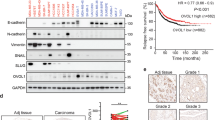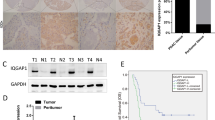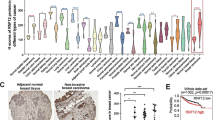Abstract
Epithelial-to-mesenchymal transition (EMT) causes fibrosis, cancer progression and metastasis. Integrin-linked kinase (ILK) is a focal adhesion adaptor and a serine/threonine protein kinase that regulates cell proliferation, survival and EMT. Elucidating the molecular mechanisms necessary for development and progression of human malignancies is critical to predict the most appropriate targets for cancer therapy. Here, we used transforming growth factor beta-1 (TGFβ-1) to promote EMT and migration in mammary epithelial cells. We demonstrate a requirement of ILK activity for TGFβ-1-mediated EMT in mammary epithelial cells. In addition to nuclear translocation of Snail and Slug, TGFβ-1 treatment also induced expression of the mammalian target of rapamycin complex 2 component Rictor and its phosphorylation on Thr1135. Interestingly, TGFβ-1 treatment also induced an interaction between ILK and Rictor. All of these TGFβ-1-induced processes were significantly suppressed by inhibiting ILK activity or by disrupting the ILK/Rictor complex using small-interfering RNA-mediated knockdown. Furthermore, we identified ILK/Rictor complex formation in cancer but not in normal cell types, and this was accompanied by ILK-dependent phosphorylation of Rictor on residue Thr1135. Inhibition of ILK partially reversed the basal mesenchymal phenotype of MDA-MB-231 cells and prevented EMT in MCF10A cells after TGFβ-1 treatment. These data demonstrate a requirement for ILK function in TGFβ-1-induced EMT in mammary epithelial cells and identify the ILK/Rictor complex as a potential molecular target for preventing/reversing EMT.
This is a preview of subscription content, access via your institution
Access options
Subscribe to this journal
Receive 50 print issues and online access
$259.00 per year
only $5.18 per issue
Buy this article
- Purchase on Springer Link
- Instant access to full article PDF
Prices may be subject to local taxes which are calculated during checkout








Similar content being viewed by others
References
McPhee TR, McDonald PC, Oloumi A, Dedhar S . Integrin-linked kinase regulates E-cadherin expression through PARP-1. Dev Dyn 2008; 237: 2737–2747.
Savagner P . Leaving the neighborhood: molecular mechanisms involved during epithelial-mesenchymal transition. Bioessays 2001; 23: 912–923.
Papanikolaou S, Bravou V, Gyftopoulos K, Nakas D, Repanti M, Papadaki H . ILK expression in human basal cell carcinoma correlates with epithelial-mesenchymal transition markers and tumour invasion. Histopathology 2010; 56: 799–809.
Bhowmick NA, Ghiassi M, Bakin A, Aakre M, Lundquist CA, Engel ME et al. Transforming growth factor-beta1 mediates epithelial to mesenchymal transdifferentiation through a RhoA-dependent mechanism. Mol Biol Cell 2001; 12: 27–36.
Margadant C, Sonnenberg A . Integrin-TGF-beta crosstalk in fibrosis, cancer and wound healing. EMBO Rep 2010; 11: 97–105.
Li Y, Tan X, Dai C, Stolz DB, Wang D, Liu Y . Inhibition of integrin-linked kinase attenuates renal interstitial fibrosis. J Am Soc Nephrol 2009; 20: 1907–1918.
Fielding AB, Dobreva I, Dedhar S . Beyond focal adhesions: integrin-linked kinase associates with tubulin and regulates mitotic spindle organization. Cell Cycle 2008; 7: 1899–1906.
McDonald PC, Fielding AB, Dedhar S . Integrin-linked kinase–essential roles in physiology and cancer biology. J Cell Sci 2008; 121: 3121–3132.
Troussard AA, McDonald PC, Wederell ED, Mawji NM, Filipenko NR, Gelmon KA et al. Preferential dependence of breast cancer cells versus normal cells on integrin-linked kinase for protein kinase B/Akt activation and cell survival. Cancer Res 2006; 66: 393–403.
McDonald PC, Oloumi A, Mills J, Dobreva I, Maidan M, Gray V et al. Rictor and integrin-linked kinase interact and regulate Akt phosphorylation and cancer cell survival. Cancer Res 2008; 68: 1618–1624.
Foster KG, Fingar DC . Mammalian target of rapamycin (mTOR): conducting the cellular signaling symphony. J Biol Chem 2010; 285: 14071–14077.
Treins C, Warne PH, Magnuson MA, Pende M, Downward J . Rictor is a novel target of p70 S6 kinase-1. Oncogene 2010; 29: 1003–1016.
Julien LA, Carriere A, Moreau J, Roux PP . mTORC1-activated S6K1 phosphorylates Rictor on threonine 1135 and regulates mTORC2 signaling. Mol Cell Biol 2010; 30: 908–921.
Boulbes D, Chen CH, Shaikenov T, Agarwal NK, Peterson TR, Addona TA et al. Rictor phosphorylation on the Thr-1135 site does not require mammalian target of rapamycin complex 2. Mol Cancer Res 2010; 8: 896–906.
Kavvadas P, Kypreou KP, Protopapadakis E, Prodromidi E, Sideras P, Charonis AS . Integrin-linked kinase (ILK) in pulmonary fibrosis. Virchows Arch 2010; 457: 563–575.
Matsui Y, Assi K, Ogawa O, Raven PA, Dedhar S, Gleave ME et al. The importance of integrin-linked kinase in the regulation of bladder cancer invasion. Int J Cancer 2012; 130: 521–531.
Somasiri A, Howarth A, Goswami D, Dedhar S, Roskelley CD . Overexpression of the integrin-linked kinase mesenchymally transforms mammary epithelial cells. J Cell Sci 2001; 114: 1125–1136.
Valcourt U, Kowanetz M, Niimi H, Heldin CH, Moustakas A . TGF-beta and the Smad signaling pathway support transcriptomic reprogramming during epithelial-mesenchymal cell transition. Mol Biol Cell 2005; 16: 1987–2002.
Hannigan G, Troussard AA, Dedhar S . Integrin-linked kinase: a cancer therapeutic target unique among its ILK. Nat Rev Cancer 2005; 5: 51–63.
Futterman MA, Garcia AJ, Zamir EA . Evidence for partial epithelial-to-mesenchymal transition (pEMT) and recruitment of motile blastoderm edge cells during avian epiboly. Dev Dyn 2011; 240: 1502–1511.
Zhao JH, Luo Y, Jiang YG, He DL, Wu CT . Knockdown of beta-catenin through shRNA cause a reversal of EMT and metastatic phenotypes induced by HIF-1alpha. Cancer Invest 2011; 29: 377–382.
Mikami S, Katsube K, Oya M, Ishida M, Kosaka T, Mizuno R et al. Expression of Snail and Slug in renal cell carcinoma: E-cadherin repressor Snail is associated with cancer invasion and prognosis. Lab Invest 2011; 91: 1443–1458.
Tan C, Costello P, Sanghera J, Dominguez D, Baulida J, de Herreros AG et al. Inhibition of integrin linked kinase (ILK) suppresses beta-catenin-Lef/Tcf-dependent transcription and expression of the E-cadherin repressor, snail, in APC-/- human colon carcinoma cells. Oncogene 2001; 20: 133–140.
Shih JY, Yang PC . The EMT regulator slug and lung carcinogenesis. Carcinogenesis 2011; 32: 1299–1304.
Zavadil J, Bottinger EP . TGF-beta and epithelial-to-mesenchymal transitions. Oncogene 2005; 24: 5764–5774.
Gulhati P, Bowen KA, Liu J, Stevens PD, Rychahou PG, Chen M et al. mTORC1 and mTORC2 regulate EMT, motility, and metastasis of colorectal cancer via RhoA and Rac1 signaling pathways. Cancer Res 2011; 71: 3246–3256.
Gao H, Steffen MC, Ramos KS . Osteopontin regulates alpha-smooth muscle actin and calponin in vascular smooth muscle cells. Cell Biol Int 2012; 36: 155–161.
Thiery JP . Epithelial-mesenchymal transitions in tumour progression. Nat Rev Cancer 2002; 2: 442–454.
Jing Y, Han Z, Zhang S, Liu Y, Wei L . Epithelial-mesenchymal transition in tumor microenvironment. Cell Biosci 2011; 1: 29.
Jo M, Lester RD, Montel V, Eastman B, Takimoto S, Gonias SL . Reversibility of epithelial-mesenchymal transition (EMT) induced in breast cancer cells by activation of urokinase receptor-dependent cell signaling. J Biol Chem 2009; 284: 22825–22833.
Dibble CC, Asara JM, Manning BD . Characterization of Rictor phosphorylation sites reveals direct regulation of mTOR complex 2 by S6K1. Mol Cell Biol 2009; 29: 5657–5670.
Hong-Brown LQ, Brown CR, Navaratnarajah M, Huber DS, Lang CH . Alcohol-induced modulation of Rictor and mTORC2 activity in C2C12 myoblasts. Alcohol Clin Exp Res 2011; 35: 1445–1453.
Piek E, Moustakas A, Kurisaki A, Heldin CH, ten Dijke P . TGF-(beta) type I receptor/ALK-5 and Smad proteins mediate epithelial to mesenchymal transdifferentiation in NMuMG breast epithelial cells. J Cell Sci 1999; 112: 4557–4568.
Lamb RF, Hennigan RF, Turnbull K, Katsanakis KD, MacKenzie ED, Birnie GD et al. AP-1-mediated invasion requires increased expression of the hyaluronan receptor CD44. Mol Cell Biol 1997; 17: 963–976.
Bhowmick NA, Zent R, Ghiassi M, McDonnell M, Moses HL . Integrin beta 1 signaling is necessary for transforming growth factor-beta activation of p38MAPK and epithelial plasticity. J Biol Chem 2001; 276: 46707–46713.
Bakin AV, Tomlinson AK, Bhowmick NA, Moses HL, Arteaga CL . Phosphatidylinositol 3-kinase function is required for transforming growth factor beta-mediated epithelial to mesenchymal transition and cell migration. J Biol Chem 2000; 275: 36803–36810.
Lee YI, Kwon YJ, Joo CK . Integrin-linked kinase function is required for transforming growth factor beta-mediated epithelial to mesenchymal transition. Biochem Biophys Res Commun 2004; 316: 997–1001.
Dong C, Li Z, Alvarez Jr R, Feng XH, Goldschmidt-Clermont PJ . Microtubule binding to Smads may regulate TGF beta activity. Mol Cell 2000; 5: 27–34.
Gil D, Ciolczyk-Wierzbicka D, Dulinska-Litewka J, Zwawa K, McCubrey JA, Laidler P . The mechanism of contribution of integrin linked kinase (ILK) to epithelial-mesenchymal transition (EMT). Adv Enzyme Regul 2011; 51: 195–207.
Kalluri R, Weinberg RA . The basics of epithelial-mesenchymal transition. J Clin Invest 2009; 119: 1420–1428.
Persad S, Troussard AA, McPhee TR, Mulholland DJ, Dedhar S . Tumor suppressor PTEN inhibits nuclear accumulation of beta-catenin and T cell/lymphoid enhancer factor 1-mediated transcriptional activation. J Cell Biol 2001; 153: 1161–1174.
Bachelder RE, Yoon SO, Franci C, de Herreros AG, Mercurio AM . Glycogen synthase kinase-3 is an endogenous inhibitor of Snail transcription: implications for the epithelial-mesenchymal transition. J Cell Biol 2005; 168: 29–33.
Doble BW, Woodgett JR . Role of glycogen synthase kinase-3 in cell fate and epithelial-mesenchymal transitions. Cells Tissues Organs 2007; 185: 73–84.
Zhou BP, Deng J, Xia W, Xu J, Li YM, Gunduz M et al. Dual regulation of Snail by GSK-3beta-mediated phosphorylation in control of epithelial-mesenchymal transition. Nat Cell Biol 2004; 6: 931–940.
Dzwonek J, Preobrazhenska O, Cazzola S, Conidi A, Schellens A, van Dinther M et al. Smad3 is a key nonredundant mediator of transforming growth factor beta signaling in Nme mouse mammary epithelial cells. Mol Cancer Res 2009; 7: 1342–1353.
de Bessa Garcia SA, Pereira MC, Nagai MA . Expression pattern of the pro-apoptotic gene PAR-4 during the morphogenesis of MCF-10A human mammary epithelial cells. Cancer Microenviron 2010; 4: 33–38.
Oh JS, Kucab JE, Bushel PR, Martin K, Bennett L, Collins J et al. Insulin-like growth factor-1 inscribes a gene expression profile for angiogenic factors and cancer progression in breast epithelial cells. Neoplasia 2002; 4: 204–217.
Sarbassov DD, Ali SM, Sengupta S, Sheen JH, Hsu PP, Bagley AF et al. Prolonged rapamycin treatment inhibits mTORC2 assembly and Akt/PKB. Mol Cell 2006; 22: 159–168.
Garcia G, Rodriguez-Puyol M, Alajarin R, Serrano I, Sanchez-Alonso P, Griera M et al. Losartan-antioxidant hybrids: novel molecules for the prevention of hypertension-induced cardiovascular damage. J Med Chem 2009; 52: 7220–7227.
Acknowledgements
This study was supported by grants to SD from the Canadian Cancer Society Research Institute (CCSRI) and the Canadian Institutes for Health Research (CIHR). We thank Quadra Logic Technology Inc (QLT Inc), Vancouver, BC, for supplying QLT-0267.
Author information
Authors and Affiliations
Corresponding author
Ethics declarations
Competing interests
The authors declare no conflict of interest.
Additional information
Supplementary Information accompanies the paper on the Oncogene website
Supplementary information
Rights and permissions
About this article
Cite this article
Serrano, I., McDonald, P., Lock, F. et al. Role of the integrin-linked kinase (ILK)/Rictor complex in TGFβ-1-induced epithelial–mesenchymal transition (EMT). Oncogene 32, 50–60 (2013). https://doi.org/10.1038/onc.2012.30
Received:
Revised:
Accepted:
Published:
Issue Date:
DOI: https://doi.org/10.1038/onc.2012.30
Keywords
This article is cited by
-
Understanding crosstalk of organ tropism, tumor microenvironment and noncoding RNAs in breast cancer metastasis
Molecular Biology Reports (2023)
-
The kinase activity of integrin-linked kinase regulates cellular senescence in gastric cancer
Cell Death & Disease (2022)
-
Integrin-linked kinase (ILK): the known vs. the unknown and perspectives
Cellular and Molecular Life Sciences (2022)
-
Transcriptomic analysis of the seminal vesicle response to the reproductive toxicant acrylamide
BMC Genomics (2021)
-
Targeting the ILK/YAP axis by LFG-500 blocks epithelial–mesenchymal transition and metastasis
Acta Pharmacologica Sinica (2021)



